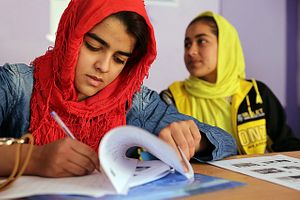There was a painful irony in the news last week that the famed green-eyed Afghan girl whose portrait on a 1985 National Geographic cover brought the plight of Afghan refugees (fleeing the Soviet war) to millions was arrested in Pakistan for possessing a fraudulent Pakistani national identity card. Sharbat Gula, now 44, apparently secured a Pakistani ID in 1988 while also keeping hold of her Afghan passport. The arrest highlighted several issues, not the least of which is Pakistan’s intensifying crackdown among Afghan refugees and the devastating reality that the region has been embroiled in war for lifetimes.
Gula is but one woman, though the plights and pitfalls of her life are experiences many Afghan women share. Afghanistan — beset by decades of war and insecurity — has lagged behind with regard to improving the lot of women, in particular. While there has been some progress, many women like Gula, who have split their lives between refugee camps in Pakistan and rural villages in Afghanistan, have yet to see their status in society improve or their opportunities multiply.
The Special Inspector General for Afghanistan Reconstruction, an independent U.S. body tasked with keeping tabs on how U.S taxpayer money has been spent in Afghanistan, included a special essay on women in its latest quarterly report. The section leads with a comment based on the UN Development Programme’s 2015 Human Development Report which put Afghanistan near the bottom when it comes to gender indicators. “Fifteen years after the United States ousted the Taliban regime, Afghanistan remains one of the worst places in the world to be a woman,” the SIGAR report says. Barriers to participating in public and political life — obtaining education and employment, for example — remain high as do reports of forced marriages and domestic violence rates.
According to SIGAR, the United States has committed at least $1 billion for projects and programs targeted at improving conditions for Afghan women. But this is not a problem money alone can solve.
Most disturbing among the stats listed in the report are those which point to societal and political apathy for raising the status and conditions for women. A public opinion survey run by the Asia Foundation found that support for “equal representation of men and women in political leadership positions” had declined between 2008 and 2015 from 51.1 percent to 43.6 percent. At the same time, the percent that say political leadership positions should be mostly for men has risen from 36.8 percent in 2006 to 42.3 percent in 2015.
SIGAR spoke to 40 prominent Afghan women and notes that the essay reflects their comments, not SIGAR’s opinion. The section is also prefaced with the facts that the women interviewed are highly educated and mostly reside in the Kabul area. In other words, these were the elite, the determined, and the lucky. Among those interviewed were Afghan First Lady Rula Ghani; Fatima Gailani, the former head of the Afghan Red Crescent Society; Ghouti, an Afghan Border Guards colonel; Nazifa Zaki, a member of parliament and a former Afghan National Police general and Shafiqa Habibi, head of the Afghan Women’s Journalist Union. Most Afghan women live in rural areas and 75 percent are illiterate. The interviews may not be representative of the average Afghan woman’s experience, but they are sampling of female leaders in various fields.
According to the interviews, security and corruption are the biggest barriers to improving the lives of women in Afghanistan (but to be frank, security and corruption are the biggest barriers to absolutely every kind of progress in Afghanistan whether political or economic). Poor security means it is difficult for women to go to school, work outside the home, or participate in civil society or politics and corruption both makes it difficult for women to compete on a level field with men, or be promoted, and also siphons off funds intended to benefit women. There’s also a degree of backlash to reforms and international pressure for reforms.
Despite that backlash and slow progress, the interviewees stressed that U.S. pressure cannot let up, “they credited the constant pressure from the United States and its allies on successive Afghan governments for many of the gains they have made.”
The essay notes that terms like “women’s rights” and “women’s empowerment” are “controversial in the Afghan cultural context.”
A government official commented, “‘Women’s empowerment’ makes it seem like women are going to take down the male-dominated system.” Mrs. [Rula] Ghani said she preferred the term “mutual respect between men and women” to “women’s rights.”
It’s worth pointing out that such phrases (along with the dreaded term “feminist”) remain controversial for an overactive minority around the world, it’s not just the Afghan cultural context that causes men (and women) to chafe at the spectre of “women’s empowerment.”
Just as when the Afghan government began seeking negotiations with the Taliban — under which women suffered immensely and gender progress made in both the communist era and that of King Zahir Shah in the 70s was reversed — a central worry is that the concerns of women will fall to the wayside.
Habibi said in her interview that “[t]he international community needs to keep the faith.” The women of Afghanistan are counting on it.

































